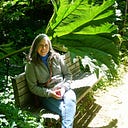Personal Prairie Patch
A few years ago we let a bordered garden bed in which we used to grow pumpkins and other vegetables go unplanted. I was learning about native plants and the importance of prairies, so I had an idea to let this garden be a mini-prairie patch in our yard. The space is 36 feet by 30 feet, so it’s fairly large for a yard, but not large at all compared to a “real” prairie.
I read about how to convert lawn into a prairie, so we covered the patch with a black tarp and let it sit… for two years. This is only one way to get rid of unwanted weeds and grasses which is necessary prior to sowing prairie plants, and it works but one has to be patient. I’ll admit the two summers we had nothing in that garden space drove me a little nuts.
And, I’m sure it drove our new neighbors a little nuts too. A new development was cut into a cornfield adjacent to the prairie patch and a neighbor’s back yard abutted the covered area. She is a very nice elderly woman and only asked once what was going on with the “garden” behind her house. I could be found wandering back to the area because my rose milkweed patch is only ten feet away, behind our barn.
Two years ago, we threw in seed that I picked up on a visit to Seed Savers Exchange in Decorah, Iowa. It is a dry Wildflower Mix that had many recognizable prairie plants listed on the package. For less than an ounce of seed, it was expensive — $12.99, I believe. But, I wanted to provide for the pollinators that visit our yard during the summer months and this mix came from a reputable source. The only other place locally I would buy native seed mixes from would be Prairie Moon Nursery in Winona, MN.
Before broadcasting the seed, we tore off the tarp. My husband tilled it up to aerate the soil and I sprinkled the seed. It is recommended that the seed be lightly raked to ensure good soil contact. I had a few other packages of native seeds from Prairie Moon, so we broadcast those as well.
In our particular packet were the following seeds: Lead Plant, Butterfly Week, Smooth Blue Aster, Upland White Aster, Canada Milk Vetch, White Wild Indigo, Partridge Pea, Sand Coreopsis, White Prairie Clover, Purple Prairie Clover, Dotted Blazing Star, Wild Bergamot, Wild Quinine, Foxglove Beardtongue, Long Headed Coneflower, Black-eyed Susan, Stiff Goldenrod, Hoary Vervain, and Golden Alexander.
Last spring I did not notice much, but by fall we had several patches of the yellow flowers mentioned in the above list. And this summer, it is a sea of yellow and white! It is gorgeous! I’m keeping track of what is blooming and testing my skills of plant identification against a prairie plant book that I splurged on for myself.
We will eventually have to leave our personal prairie patch due to moving, but we have plans to minimize our lawn at our new property and restore what was is left of a remnant prairie of several acres. I’m excited to grow a prairie again — this one is so beautiful!
Originally published at http://theapplesinmyorchard.com on June 28, 2021.
